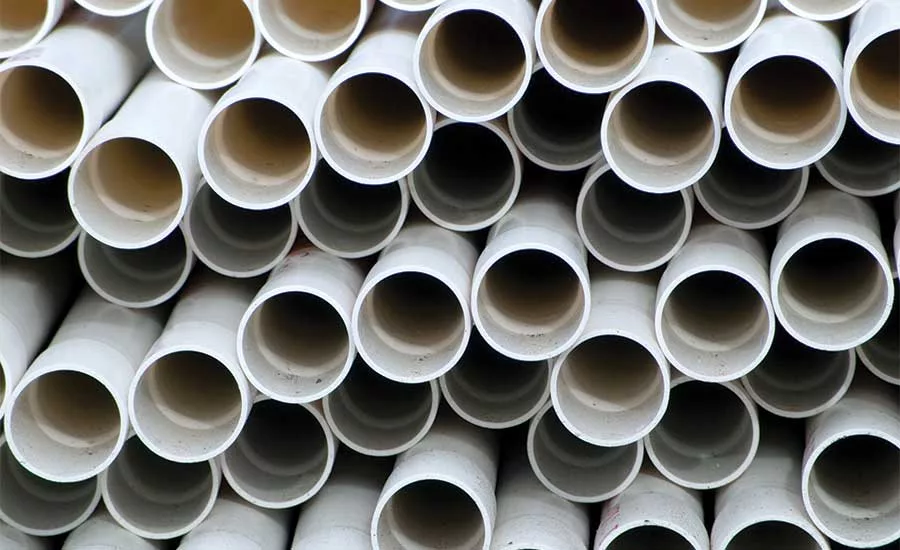What Are the Limits of PVC Drilling Pipe?

A lot of drillers (probably more than half) use PVC casing for most of their domestic wells. It is inexpensive, reliable, never rusts and, used within limits, will make a lifetime well. However, PVC has one major drawback: It is not as strong as steel pipe. This means that setting depths are limited, and you can’t get too rough with it either. A good, clean hole helps.
Figuring out maximum setting depth is fairly straightforward. The strength of the material times the joint weight will give you the max theoretical setting depth. “Theoretical” is the key word. It’s not a good idea to set at maximum theoretical depths, in case you have to work a tight spot or stick it. Having a little “in your back pocket” is always a good idea. Part of the strength of any solid is called the modulus of elasticity. Within this range, a material can be bent, compressed or stretched, and return to its original shape. Beyond this limit, permanent deformation happens. Beyond that, the material fails catastrophically. With pipe, you can pull on it within limits and it will return to its original dimensions. Beyond that, it will take a permanent stretch and will be weakened or part. Imagine a rubber band. It will stretch many times and return, but over pull it and it will break. Pipe is the same.
With PVC pipe, the modulus of elasticity is much lower than steel. It will stretch more easily, but have less overall strength. This is important to water well drillers because you might not have enough rig to pull steel casing in two, but you probably have plenty of power to part PVC. It is also more elastic than steel and will stretch a lot more for a given pull.
If you are going in the hole with a string of casing and stick it off bottom, knowing the exact depth at which you are stuck will help you determine the best course of action. It’s a lot different to be stuck on bottom than to have a shallow sand fall in on the hole and stick you at a shallow depth. By carefully pulling on the casing, you can get an idea of how deep you’re stuck. If it doesn’t stretch much at all, you are stuck fairly shallow. If you can stretch it many inches for a given pull, you are stuck much deeper.
During my fishing career, I often had to respond to a stuck pipe job. One of the first things I usually do is pull on the pipe, stretch it, note the weight and measure the stretch in inches. Then the exact dimensions of the pipe, the grade and the amount of over pull would tell me approximately how deep it had stuck. This calculation ignores friction, so it makes a difference whether you are in casing or open hole. With stuck tubing inside a string of casing, I could often calculate almost to the exact joint where I was stuck. Not so much in open hole or horizontal wells. This helps a lot when planning a back-off or pipe-cutting procedures. It saves the wireline guys a lot of time not having to work up and down the pipe to find the stuck point. Once they had confirmed the stuck point, I could plan a string-shot, back-off (usually) one full joint above. Then I could screw in a jarring assembly or prepare for a washover.
The procedure for stretch calculations is fairly simple. Pick up the pipe to the neutral point. This is the weight just before it got stuck. Pull a small amount over this and mark the pipe. Pull slightly more and mark the pipe again. Repeat this a couple times with increasing pull, and you will be able to calculate the amount of pipe you are stretching; thus, telling you how deep you are stuck. Be careful and don’t pull too much. PVC can fail catastrophically, usually at a fairly shallow depth, causing a lot of iron flying around and leading to a much more complicated fishing job.
When making your calculations, it is important to know the exact dimensions of your pipe. Don’t depend on the catalog dimensions. Caliper the pipe yourself. OD squared minus ID squared equals area in square inches of the pipe. This, when coupled with the modulus of elasticity, will tell you the strength of the pipe and the amount of stretch per 1,000 pounds of pull. Often, small rigs do not have weight indicators, adding to the guesswork involved. I have found that a good initial stretch can often be safely made by idling the engine all the way down. When you pull, on many mechanical rigs, it will stall the engine. This is your baseline. You can come back to it whenever you need. Then throttle up and pull a little harder. Often on jobs like this, I carry a portable weight indicator with me that I can rig up to get very accurate measurements— an invaluable tool for a fisherman.
After I have determined the depth of the problem, I can figure out how much to safely pull on it and work the pipe. If I’m making progress, I keep going. If not, further measures are called for.
I will save the recovery procedures for another day, and hope that you don’t stick your pipe in the meantime.
Keep ’em turning to the right and give me a call if you get in a bind.
For more Wayne Nash columns, visit www.thedriller.com/wayne.
Looking for a reprint of this article?
From high-res PDFs to custom plaques, order your copy today!



